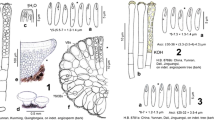Abstract
A member of the nematophagous anamorph genus Arthrobotrys was isolated from its teleomorph Orbilia blumenaviensis comb. nov. (= Orbilia fici), a species closely related to O. auricolor but deviating in having lanceolate paraphyses. In the presence of nematodes, the anamorph forms three-dimensional adhesive networks. A trimorphism in its conidia was observed which vary in shape and number of septa. In the first isolate, two types of heteropolar conidia were obtained. These differ markedly from the type strain of A. vermicola, which forms mainly homopolar (fusoid) conidia. In a further ascospore isolate of O. blumenaviensis, however, mainly fusoid conidia referable to A. vermicola occurred. Combining morphological and phylogenetic analysis, we conclude that these isolates with differently shaped conidia and/or differences in the ITS rDNA (ca. 2–4%) belong to a single anamorph species, A. vermicola. Both teleomorph and anamorph are illustrated and described.





Similar content being viewed by others
Abbreviations
- *:
-
Living state
- †:
-
Dead state
References
Baral HO (1992) Vital versus herbarium taxonomy: morphological differences between living and dead cells of Ascomycetes, and their taxonomic implications. Mycotaxon 44:333–390
Cooke RC, Satchuthananthavale V (1965) Some nematode-trapping species of Dactylaria. Trans Br Mycol Soc 49:27–32
Kirk PM, Cannon PF, David JC et al (2008) Ainsworth & Bisby’s dictionary of the fungi, 10th edn. CAB International, Wallingford
Li Y, Jeewon R, Hyde KD, Mo MH, Zhang KQ (2006) Two new species of nematode-trapping fungi: relationships inferred from morphology, rDNA and protein gene sequence analyses. Mycol Res 110:790–800
Liou GY, Tzean SS (1997) Phylogeny of the genus Arthrobotrys and allied nematode-trapping fungi based on rDNA sequences. Mycologia 89:876–884
Mo MH, Huang XW, Zhou W, Huang Y, Hao YE, Zhang KQ (2005) Arthrobotrys yunnanensis sp. nov., the fourth ananmorph of Orbilia auricolor. Fungal Divers 18:107–115
Oorschot CAN van (1985) Taxonomy of the Dactylaria complex. V. A review of Arthrobotrys, an allied genera. Stud Mycol 26:61–96
Swe A, Jeewoon R, Hyde KD (2008) Nematode-trapping fungi from mangrove habitats. Cryptogam Mycol 29:333–354
Turner D, Kovacs W, Kuhls K et al (1997) Biogeography and phenotypic variation in Trichoderma sect. Longibrachiatum and associated Hypocrea species. Mycol Res 101:449–459
White TJ, Bruns T, Lee S et al. (1990) Amplification and direct sequencing of fungal ribosomal RNA genes for phylogenetics. In: Innis MA et al (eds), PCR Protocols: a guide to methods and applications. Academic Press, San Diego, 315–322
Yang Y, Yang E, An Z, Liu XZ (2007) Evolution of nematode-trapping cells of predatory fungi of the Orbiliaceae based on evidence from rRNA-encoding DNA and multiprotein sequences. Proc Natl Acad Sci USA 104:8379–8384
Yu ZF, Zhang Y, Qiao M, Baral HO, Weber E, Zhang KQ (2006) Drechslerella brochopaga, the anamorph of Orbilia (Hyalinia) orientalis. Mycotaxon 96:163–168
Zhang KQ, Mo MH (2006) Flora fungorum sinicorum, vol. 33. Arthrobotrys et genera cetera cognata. Science Press, Beijing (in Chinese)
Zhang Y, Yu ZF, Baral HO, Qiao M, Zhang KQ (2007) Pseudorbilia gen. nov. (Orbiliaceae) from Yunnan, China. Fungal Divers 26:305–312
Acknowledgements
This work was jointly financed by ‘National Basic Research Program of China’ (2007CB411600), National Natural Science Foundation Program of PR China (30860004, 30960017, 31060008), Grants from the Young Academic and Technical Leader Raising Foundation of Yunnan Province (2010CI020, 2010CI106), and grant from Yunnan University (2010ZD004). Two anonymous reviewers are thanked for their detailed comments on this paper.
Author information
Authors and Affiliations
Corresponding author
Additional information
Min Qiao and Ying Zhang contributed equally to this work.
Rights and permissions
About this article
Cite this article
Qiao, M., Zhang, Y., Li, SF. et al. Orbilia blumenaviensis and its Arthrobotrys anamorph. Mycol Progress 11, 255–262 (2012). https://doi.org/10.1007/s11557-011-0744-3
Received:
Revised:
Accepted:
Published:
Issue Date:
DOI: https://doi.org/10.1007/s11557-011-0744-3




